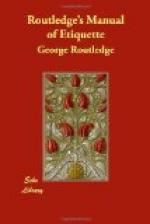XXI.—THE COTILLON.
The Cotillon is rarely seen in English ball-rooms, but on the Continent, especially in Italy, it is a great favourite. It occupies a somewhat similar position to our own Sir Roger de Coverley, being generally the concluding dance of the evening, in which every one joins. It can be prolonged at pleasure by the introduction of more figures, for it has no definite beginning or end. It is, in fact, more like a long game performed to the accompaniment of valse music than a dance.
We shall describe the Cotillon as we have seen it in the palaces of Italy, where it is danced with enthusiasm, and diversified by an innumerable variety of figures, only a few of which we can undertake to remember. It is never commenced till towards the close of the ball, at so advanced an hour that all the sober portion of the assembly have retired, and only the real lovers of dancing remain, who sometimes prolong this their favourite amusement till a late hour in the morning.
It is customary for gentlemen to select their partners for the Cotillon early in the evening, while the other dances are in progress; for, as it lasts so long a time, it is necessary to know beforehand how many ladies feel inclined to remain during its continuance.
A circle of chairs is arranged round the room, the centre being left clear; the spectators stand behind the chairs, so as not to interfere with the dancers. Each gentleman leads his partner to a seat, taking another beside her. To these same seats they return after every figure, it being the etiquette of the dance that no couple should appropriate any chairs but their own, taken at the commencement. When the dancers are arranged round the room, the orchestra strikes up the spirited music of the Cotillon, which consists of a long series of valse movements at the usual tempo of the Deux Temps. There are generally several leaders of the Cotillon, who decide upon the succession of the figures. If there are many couples dancing, one leader attends upon a group of six or eight couples, to ensure that all shall take part. We are aware of no fixed rule for the succession of the figures, which depends upon the caprice of the leaders. A good leader will invent new combinations, or diversify old figures; thus securing an almost endless variety. One of the most popular is the following:—
Several gentlemen assume the names of flowers or plants, such as the honeysuckle, woodbine, ivy, &c. A lady is then requested to name her favourite flower; and the fortunate swain who bears its name springs forward and valses off with her in triumph. It is usual to make one, or at most two, turns round the room, and then restore the lady to her own partner, who in the meantime has perhaps been the chosen one of another lady. All having regained their places, each gentleman valses with his own partner once round the room, or remains sitting by her side, as she may feel inclined.




